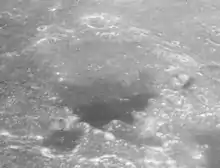Julius Caesar (crater)
Julius Caesar is a lava-flooded lunar impact crater with a low, irregular, and heavily worn wall. Its diameter is 85 km. It was named after Roman statesman Julius Caesar.[1] It is located to the west of Mare Tranquillitatis, and directly southeast of the crater Manilius on the Mare Vaporum. To the east is the rounded Sosigenes.
 Mosaic of Lunar Orbiter 4 images (White blemishes in lower left are present on original images) | |
| Coordinates | 9.0°N 15.4°E |
|---|---|
| Diameter | 85 km |
| Depth | 3.4 km |
| Colongitude | 345° at sunrise |
| Eponym | Julius Caesar |



The interior floor of Julius Caesar is relatively level, especially in the southwest half. The northern half of the interior has a lower albedo (darker) than the south. Most likely the floor has been covered or modified by ejecta from the impact that created the Imbrium basin. There are a number of crater remnants overlapping the rim along the south and northeast edges. A low ridge crosses the floor across the northeast sections of the crater.
Satellite craters
By convention these features are identified on lunar maps by placing the letter on the side of the crater midpoint that is closest to Julius Caesar.
| Julius Caesar |
Latitude | Longitude | Diameter |
|---|---|---|---|
| A | 7.6° N | 14.4° E | 13 km |
| B | 9.8° N | 14.0° E | 7 km |
| C | 7.3° N | 15.4° E | 5 km |
| D | 7.2° N | 16.5° E | 5 km |
| F | 11.5° N | 12.9° E | 19 km |
| G | 10.2° N | 15.7° E | 20 km |
| H | 8.8° N | 13.6° E | 3 km |
| J | 9.2° N | 14.1° E | 3 km |
| P | 11.2° N | 14.1° E | 37 km |
| Q | 12.9° N | 14.0° E | 32 km |
References
- "Julius Caesar (crater)". Gazetteer of Planetary Nomenclature. USGS Astrogeology Research Program.
- Andersson, L. E.; Whitaker, E. A. (1982). NASA Catalogue of Lunar Nomenclature. NASA RP-1097.
- Bussey, B.; Spudis, P. (2004). The Clementine Atlas of the Moon. New York: Cambridge University Press. ISBN 978-0-521-81528-4.
- Cocks, Elijah E.; Cocks, Josiah C. (1995). Who's Who on the Moon: A Biographical Dictionary of Lunar Nomenclature. Tudor Publishers. ISBN 978-0-936389-27-1.
- McDowell, Jonathan (July 15, 2007). "Lunar Nomenclature". Jonathan's Space Report. Retrieved 2007-10-24.
- Menzel, D. H.; Minnaert, M.; Levin, B.; Dollfus, A.; Bell, B. (1971). "Report on Lunar Nomenclature by the Working Group of Commission 17 of the IAU". Space Science Reviews. 12 (2): 136–186. Bibcode:1971SSRv...12..136M. doi:10.1007/BF00171763. S2CID 122125855.
- Moore, Patrick (2001). On the Moon. Sterling Publishing Co. ISBN 978-0-304-35469-6.
- Price, Fred W. (1988). The Moon Observer's Handbook. Cambridge University Press. ISBN 978-0-521-33500-3.
- Rükl, Antonín (1990). Atlas of the Moon. Kalmbach Books. ISBN 978-0-913135-17-4.
- Webb, Rev. T. W. (1962). Celestial Objects for Common Telescopes (6th revised ed.). Dover. ISBN 978-0-486-20917-3.
- Whitaker, Ewen A. (1999). Mapping and Naming the Moon. Cambridge University Press. ISBN 978-0-521-62248-6.
- Wlasuk, Peter T. (2000). Observing the Moon. Springer. ISBN 978-1-85233-193-1.
External links
- Julius Caesar at The Moon Wiki
- Wood, Chuck (May 11, 2005). "Imperial Image". Lunar Photo of the Day.
- Wood, Chuck (April 26, 2006). "Dead Romans". Lunar Photo of the Day. Archived from the original on June 14, 2011. Retrieved 2006-07-12.
- Wood, Chuck (December 8, 2009). "Edgy". Lunar Photo of the Day.
- Wood, Chuck (March 1, 2014). "Smoothered". Lunar Photo of the Day. - also features nearby Boscovich Crater